Papers by Francesca Vidussi
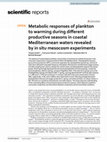
Scientific Reports, May 30, 2022
The response of coastal lagoon plankton communities to warming was studied during two in situ mes... more The response of coastal lagoon plankton communities to warming was studied during two in situ mesocosm experiments in spring and fall of 2018 in the Mediterranean. Phytoplankton biomass, gross primary production (GPP), community respiration (R), phytoplankton growth (µ), and loss (l) rates were estimated using high-frequency chlorophyll-a fluorescence and dissolved oxygen sensors, and daily sampling was used to evaluate the nutrient status and phytoplankton pigment functional groups. Warming strongly depressed the dominant phytoplankton functional groups, mainly the prymnesiophytes, diatoms (spring), and green flagellates (fall). It favored minor groups such as the dinoflagellates (spring) and diatoms (fall). In spring, warming depressed GPP and R by half; however, µ (+ 18%) and l (+ 37%) were enhanced. In contrast, both GPP and µ were enhanced by 21% and 28%, respectively, in fall, and no effects were observed for R and l. Warming strongly decreased phytoplankton biomass and oxygen production in spring, and enhanced them, to a lesser extent, in fall. This led to an overall loss of production over both seasons. This study improves understanding of the contrasting effects of warming during two productive seasons, which depend on plankton community composition and interactions between components and environmental conditions. Surface ocean temperatures have increased globally in recent decades and are expected to have considerable effects on plankton communities and their metabolic processes 1,2. According to Arrhenius' Law 3 , an increase in temperature directly enhances plankton metabolic rates through interactions with biological processes and enzymatic activities 4,5. The composition of plankton communities can also be affected, as more thermally adapted groups outcompete others. Thus, increases in water temperature affect plankton food webs, as they modify the interactions between organisms 6,7 and lead to complex trophic cascades 8. Warming can also increase the abundance and activity of grazers 9-11 , resulting in potentially higher grazing pressures on primary and secondary producers. Warming can also modify the physical parameters of the water column by altering resource availability and plankton metabolism. Global-scale warming is not homogenous, as certain regions are more sensitive than others. Among these hotspots, the Mediterranean Sea is considered particularly sensitive to global warming 12,13. The sea surface temperature (SST) here is predicted to increase by 3 °C by the end of the century 14 , and it will have important consequences for the plankton community, especially during highly productive spring blooms 8,15. However, little is known about the effects of warming during fall, which is the other productive season 7. It is unclear whether warming will have similar effects on different plankton communities and environmental conditions. Plankton communities are major contributors to multiple biogeochemical cycles, notably those of carbon and oxygen 16. Phytoplankton produces oxygen through gross primary production (GPP), and all planktonic organisms consume oxygen through aerobic respiration (R). Consequently, plankton plays an important role in the capacity of marine ecosystems to act as net sources or sinks of oxygen 17. In a natural environment, phytoplankton
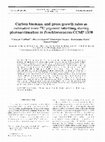
Marine Ecology Progress Series, 1996
The 14C labelling of chlorophylls and carotenoids is Increasingly used to evaluate phytoplanktomc... more The 14C labelling of chlorophylls and carotenoids is Increasingly used to evaluate phytoplanktomc biomass and growth rates in oceanlc systems. Hlgorous testing of the technique in the laboratory, however, is necessary prior to its application in the field. A Mediterranean clone of Prochlorococcus, a photosynthetic prokaryote whlch is a n important component of the aulotrophic b~omass in o l~g o t r o p h~c environments, was subjected to shifts in light intensity. Particulate organlc carbon (POC) was monitored by CHN analysis, pigments by HPLC and frochlorococcus and heterotrophlc bacteria concentrations by flow cytometry. Using a combination of HPLC and on-line rad~oact~vlty detection, I4C labelling kinetics of divinyl-chlorophyll a (DV-chl a) and zeaxanthin were follo\.ved Prochlorococcus changed ~t s DV-chl a content markedly in response to change in light ~ntenslty, but not its zeaxanthin content, which remained nearly constant around 1.07 fg cell-' regdrdless of the ~rradiance. P~g m e n t synthes~s rates were correctly est~rnated from their '"C incorporation rates whatever the light level. From POC measurcmcnts and cell concentrations, the Prochlorococcus carbon content was estimated to be 49 fg C cell-l. bioreover, under both constant and shifted (high to low and vlce versa) light conditlons, Prochlorococcus growth rate (as computed from variations in cell dens~ty) was much better estimated from zeaxanthin than fl-orn DV-chl a labelling rates.

Deep-sea Research Part I-oceanographic Research Papers, Dec 1, 1999
We analysed samples taken through the euphotic zone from 18 stations between the Ligurian Sea (63... more We analysed samples taken through the euphotic zone from 18 stations between the Ligurian Sea (63E) and the Levantin Basin (323E) from 24 May to 25 June 1996. Both ciliate and chlorophyll concentrations ranged over a factor of about 7, but ciliate concentrations (0.4}2.8 mg C m) varied irregularly compared to a longitudinal decline, west to east, in chlorophyll concentration (0.07}0.48 mg m). The lower chlorophyll concentrations (0.1 mg m) of the eastern basin stations corresponded with a relatively high stock of ciliates (0.5 mg C m). Large mixotrophic ciliates were more abundant, in both absolute and relative terms, in the eastern Mediterranean stations with less chlorophyll. The species diversity of tintinnid ciliates appeared higher in the central and eastern basins compared to the west. Our results suggest a shift from the western to eastern Mediterranean in the planktonic food towards a microbially dominated system.

Deep-sea Research Part I-oceanographic Research Papers, Mar 1, 2000
Phytoplankton taxonomic pigments and primary production were measured at the JGOFS-France time-se... more Phytoplankton taxonomic pigments and primary production were measured at the JGOFS-France time-series station DYFAMED in the northwestern Mediterranean Sea during May 1995 to investigate changes in phytoplankton composition and the biogeochemical implications (DYNAPROC experiment). The study period covered the transitional situation from late spring bloom to pre-oligotrophic. The late spring bloom situation, occurring at the beginning of the study, revealed high chlorophyll a concentrations (maximum 3 mg m\ at 30 m) and high primary production (maximum 497 mg C m\ 14 h\). At the end of the experiment, the trophic regime shifted towards pre-oligotrophic and was characterized by lower chlorophyll a concentrations ((1 mg m\), although primary production still remained high (659 mg C m\ 14 h\). At termination of the spring bloom, the phytoplankton community was composed of chromophyte nano#agellates (38$4%), diatoms (29$2%), cryptophytes (12$1%) and cyanobacteria (8$1%). During the transition to the pre-oligotrophic period, the contribution of small cells increased (e.g. cyanobacteria 18$2%, green #agellates 5$1%). Vertical pro"les of pigments revealed a partition of the phytoplankton groups: cyanobacteria were most abundant in the surface layer, nano#agellates containing 19-HF#19BF at the depth of chlorophyll maximum, whereas diatoms were located below the chlorophyll maximum. At termination of the spring bloom, a wind event induced vertical transport of nutrients into the euphotic layer. Phytoplankton groups responded di!erently to the event: initially, diatom concentrations increased (for 24 h) then rapidly decreased. In contrast, all others groups
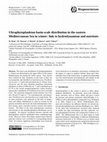
Biogeosciences, Jul 20, 2010
The basin-scale distribution of ultraphytoplankton (<10 µm) was determined in the upper 200 m of ... more The basin-scale distribution of ultraphytoplankton (<10 µm) was determined in the upper 200 m of the eastern Mediterranean Sea during the winter season. Four clusters were resolved by flow cytometry on the basis of their optical properties and identified as Synechococcus, Prochlorococcus, pico-(<3 µm) and nanoeukaryotes (3-10 µm). Synechococcus was the most abundant population (maximum abundance of about 37 000 cells cm −3) and contributed up to 67.7% to the overall ultraphytoplanktonic carbon biomass, whereas the contribution of Prochlorococcus never exceeded 6.5%. The maximum integrated carbon biomass was 1763, 453, 58 and 571 mg C m −2 for nanoeukaryotes, picoeukaryotes, Prochlorococcus and Synechococcus respectively. Water mass properties were analyzed on the basis of temperature and salinity distributions in order to account for the general circulation and locate the main hydrodynamic structures (fronts, gyres, transition between western and eastern basins). The effect of the main hydrodynamic structures and nutrients on the ultraphytoplankton distribution was investigated. No positive correlation between nutrients and phytoplankton could be established when considering large scales. However, below 50 m depth, nutrient ratios between particular stations were correlated to corresponding density ratios. In contrast, significant relationships were found be
Journal of Geophysical Research, Sep 15, 2001
HAL is a multidisciplinary open access archive for the deposit and dissemination of scientific re... more HAL is a multidisciplinary open access archive for the deposit and dissemination of scientific research documents, whether they are published or not. The documents may come from teaching and research institutions in France or abroad, or from public or private research centers. L'archive ouverte pluridisciplinaire HAL, est destinée au dépôt et à la diffusion de documents scientifiques de niveau recherche, publiés ou non, émanant des établissements d'enseignement et de recherche français ou étrangers, des laboratoires publics ou privés.
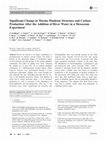
Microbial Ecology, 2017
Rivers are known to be major contributors to eutrophication in marine coastal waters, but little ... more Rivers are known to be major contributors to eutrophication in marine coastal waters, but little is known on the short-term impact of freshwater surges on the structure and functioning of the marine plankton community. The effect of adding river water, reducing the salinity by 15 and 30%, on an autumn plankton community in a Mediterranean coastal lagoon (Thau Lagoon, France) was determined during a 6-day mesocosm experiment. Adding river water brought not only nutrients but also chlorophyceans that did not survive in the brackish mesocosm waters. The addition of water led to initial increases (days 1-2) in bacterial production as well as increases in the abundances of bacterioplankton and picoeukaryotes. After day 3, the increases were more significant for diatoms and dinoflagellates that were already present in the Thau Lagoon water (mainly Pseudo-nitzschia spp. group delicatissima and Prorocentrum triestinum) and other larger organisms (tintinnids, rotifers). At the same time, the abundances of bacterioplankton, cyanobacteria, and picoeukaryote fell, some nutrients (NH 4 + , SiO 4 3−) returned to pre-input levels, and the plankton structure moved from a trophic food web based on secondary production to the accumulation of primary producers in the mesocosms with added river water. Our results also show that, after freshwater inputs, there is rapid emergence of plankton species that are potentially harmful to living organisms. This suggests that flash flood events may lead to sanitary issues, other than pathogens, in exploited marine areas.
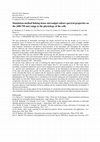
Applied spectroscopy, Jun 18, 2016
This work describes a method to model the optical properties over the (400-750 nm) spectral range... more This work describes a method to model the optical properties over the (400-750 nm) spectral range of a dense microalgal culture using the chemical and physical properties of the algal cells. The method was based on a specific program called AlgaSim coupled with the adding-doubling method: at the individual cell scale, AlgaSim simulates the spectral properties of one model, three-layer spherical algal cell from its size and chemical composition. As a second step, the adding-doubling method makes it possible to retrieve the total transmittance of the algal medium from the optical properties of the individual algal cells. The method was tested by comparing the simulated total transmittance spectra for dense marine microalgal cultures ofIsochrysis galbana(small flagellates) andPhaeodactylum tricornutum(diatoms) to spectra measured using an experimental spectrophotometric setup. Our study revealed that the total transmittance spectra simulated for the quasi-spherical cells ofIsochrysis g...
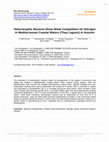
Microbial Ecology, 2015
The importance of heterotrophic bacteria relative to phytoplankton in the uptake of ammonium and ... more The importance of heterotrophic bacteria relative to phytoplankton in the uptake of ammonium and nitrate was studied in Mediterranean coastal waters (Thau Lagoon) during autumn, when the Mediterranean Sea received the greatest allochthonous nutrient loads. Specific inhibitors and sizefractionation methods were used in combination with isotopic N-15 tracers. NO3 (-) and NH4 (+) uptake was dominated by phytoplankton (60 % on average) during the study period, which included a flood event. Despite lower biomass specific NH4 (+) and NO3 uptake rates, free-living heterotrophic bacteria contributed significantly (> 30 %) to total microbial NH4 (+) and NO3 (-) uptake rates in low chlorophyll waters. Under these conditions, heterotrophic bacteria may be responsible for more than 50 % of primary production, using very little freshly produced phytoplankton exudates. In low chlorophyll coastal waters as reported during the present 3-month study, the heterotrophic bacteria seemed to depend to a greater extent on allochthonous N and C substrates than on autochthonous substrates derived from phytoplankton.
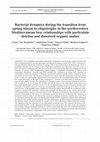
Marine Ecology Progress Series, 2001
The variability in microbial communities (abundance and biomass), bacterial production and ectoam... more The variability in microbial communities (abundance and biomass), bacterial production and ectoaminopeptidase activity, particulate and dissolved organic carbon (POC, DOC), and particulate and dissolved lipids was examined in spring 1995 in the northwestern Mediterranean, where a transition from the end of a bloom to pre-oligotrophic conditions was observed. Four time series of 36 h each and 4 h sampling intervals were performed at 5 m and at the chlorophyll maximum (30 m) between 11 and 31 May. Simultaneous measurements of pigments, abundance of hetero-and autotrophic flagellates, bacteria and POC enabled the estimation of living POC (defined as autotrophic-C plus heterotrophic-C biomass), and thus the detrital organic carbon. During the first 2 time series (11 to 15 May), the bacterial-C biomass was higher than the autotrophic-C biomass at 5 m (ratio 1.4 and 1.7), whereas the opposite trend was observed in the chlorophyll peak (ratio 0.7 for the first cycle). However, at the end of May, autotrophic-C biomass was equivalent to bacterial-C biomass at both depths studied. The detrital pool remained a more or less constant fraction of the POC (52, 53 and 47% on 11-12 May, 14-15 May and 30-31 May) at the chlorophyll peak, whereas it decreased significantly with time (62 to 53%) at 5 m. Relationships between bacterial activities and evolution of available resources were not systematically evidenced from our 36 h diel cycle data. Nevertheless, at the monthly scale, comparison of bacterial carbon demand (BCD) to potential carbon resources (detrital POC and DOC) showed that bacteria fed differently on the various pools. From ectoaminopeptidase turnover rates and detrital POC, the potential hydrolysis rate of detritus was calculated. Depending on the choice of conversion factors for bacterial production and estimates of hydrolysis turnover rates, it was shown that bacterial hydrolysis of detritus could be one of the DOC accumulation sources. We observed that the percentage of BCD supplied by detrital POC hydrolysis increased in the surface and decreased in the chlorophyll peak. An index of lipid degradation in POC, the lipolysis index, increased during the month at 5 m, also indicating a higher hydrolysis of POC. The opposite trend was observed in the chlorophyll maximum layer. The selective decrease in dissolved lipids in DOC in the chlorophyll maximum layer, particularly free fatty acids, also suggests that bacteria utilized increased fractions of carbon sources from the DOC. We concluded that partitioning between DOC and detritus as resources for bacteria can change during the rapid transition period from mesotrophy to oligotrophy in the northwestern Mediterranean.
Marine Chemistry, 1999
... These data suggest that the organic matter at 30 m depth, that situated within the fluorescen... more ... These data suggest that the organic matter at 30 m depth, that situated within the fluorescence maximum, was mainly originated from autotrophic and photosynthetic processes (Bentaleb et al., 1996; Descolas-Gros and Oriol, 1992). ...
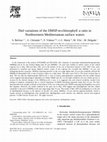
Journal of Marine Systems, 2000
In the framework of the projects DYFAMED and PICASSO, diel variations of particulate dimethylsulf... more In the framework of the projects DYFAMED and PICASSO, diel variations of particulate dimethylsulfoniopropionate Ž. Ž. DMSPp and of its size fraction higher than 10 mm DMSPp) 10 mm were studied in surface waters of the central Ž. Ligurian Sea in May 1990 and May 1995, and in the harbour of the city of Barcelona Spain in July 1998. Time series performed in stratified and nitrate depleted surface waters of the Ligurian Sea revealed that DMSPp) 10 mm was undergoing diurnal variations. DMSPp-containing particles in the size range higher than 10 mm also markedly affected the Ž. DMSPp-to-chlorophyll chl a ratio of surface waters on a daily basis. The ratios were 35% to 72% lower at dawn than at Ž. dusk. The fact that the diadinoxanthin DD-to-chl a ratio of surface phytoplanktonic populations did not exhibit diurnal cycles suggests that physiological adaptation of cellular DMSP and chl a to the light conditions was not a likely process to account for the diurnal changes of the DMSPp-to-chl a ratio. It is suggested that such diurnal variability resulted from changes in plankton composition due to vertical migrations of DMSP-containing organisms larger than 10 mm. We have demonstrated from samples collected in the harbour of the city of Barcelona that DMSP-containing dinoflagellates are active diel migrants. However, the results obtained in the open sea in May 1990 suggest that dinoflagellates and also ciliates contribute to the pool of DMSPp in the size range larger than 10 mm. The results of May 1995 are ambiguous as to the role of dinoflagellates because, in the absence of specific cell counts, DMSPp) 10 mm and the pigment peridinin, which is Ž. usually present in dinoflagellates but peridinin-free dinoflagellates exist showed very different vertical and temporal patterns.
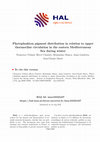
Journal of Geophysical Research: Oceans, 2001
Using a sampling grid of 67 stations, the influence of basin‐wide and subbasin‐scale circulation ... more Using a sampling grid of 67 stations, the influence of basin‐wide and subbasin‐scale circulation features on phytoplankton community composition and primary and new productions was investigated in the eastern Mediterranean during winter. Taxonomic pigments were used as size class markers of phototroph groups (picophytoplankton, nanophytoplankton and microphytoplankton). Primary production rates were computed using a light photosynthesis model that makes use of the total chlorophyll a (Tchl a) concentration profile as an input variable. New production was estimated as the product of primary production by a pigment‐based proxy of the ƒ ratio (new production/total production). For the whole eastern Mediterranean, Tchl a concentration was 20.4 mg m−2, and estimated primary and new production were 0.27 and 0.04 g C m−2 d−1, respectively, when integrated between the surface and the depth of the productive zone (1.5 times the euphotic layer). Nanophytoplankton and picophytoplankton (determ...
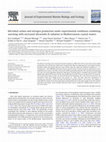
Journal of Experimental Marine Biology and Ecology, 2013
The effects of warming and increased ultraviolet-B radiation (UVBR, 280-320 nm) have been rarely ... more The effects of warming and increased ultraviolet-B radiation (UVBR, 280-320 nm) have been rarely studied at food web scale and very few studies have considered the effect of combining these two climatic stressors. Microbial carbon and nitrogen dynamics were studied under the single and combined conditions of + 3°C warming and +20% UVBR above the natural levels (control) during a 10-day mesocosm experiment in coastal Mediterranean waters. The effect of increased UVBR on primary production (PP) and bacterial production (BP) rates was rarely significant during the experiment. Warming alone or combined with increased UVBR significantly reduced BP by about 30% but also significantly increased PP by an average of 90%. No accumulation of particulate organic matter was observed during the experiment but, in the warmed mesocosms, the cumulative carbon and nitrogen losses were greater (ca. + 40%). The main short-term consequence of warming was, therefore, a shift of the food web dynamics leading to higher C and N losses. This suggests a more efficient transfer of the newly produced microbial production to the upper trophic levels and a greater exportation into deeper waters through settlement under warmer conditions in Mediterranean coastal waters in the future.
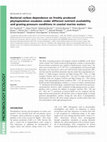
FEMS Microbiology Ecology, 2013
The effects of grazing pressure and inorganic nutrient availability on the direct carbon transfer... more The effects of grazing pressure and inorganic nutrient availability on the direct carbon transfer from freshly produced phytoplankton exudates to heterotrophic bacteria biomass production were studied in Mediterranean coastal waters. The short-term incorporation of 13 C (H 13 CO 3) in phytoplankton and bacterial lipid biomarkers was measured as well as the total bacterial carbon production (BP), viral lysis and the microbial community structure under three experimental conditions: (1) High inorganic Nutrient and High Grazing (HN + HG), (2) High inorganic Nutrient and Low Grazing (HN + LG) and (3) under natural in situ conditions with Low inorganic Nutrient and High Grazing (LN + HG) during spring. Under phytoplankton bloom conditions (HN + LG), the bacterial use of freshly produced phytoplankton exudates as a source of carbon, estimated from 13 C enrichment of bacterial lipids, contributed more than half of the total bacterial production. However, under conditions of high grazing pressure on phytoplankton with or without the addition of inorganic nutrients (HN + HG and LN + HG), the 13 C enrichment of bacterial lipids was low compared with the high total bacterial production. BP therefore seems to depend mainly on freshly produced phytoplankton exudates during the early phase of phytoplankton bloom period. However, BP seems mainly relying on recycled carbon from viral lysis and predators under high grazing pressure.








Uploads
Papers by Francesca Vidussi